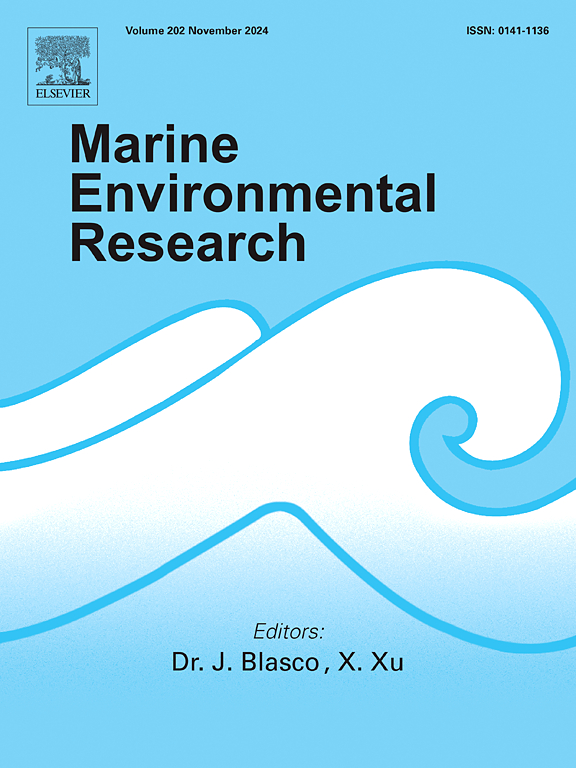检查鱼类摄入的微塑料:考虑过滤孔径、分析时间和材料成本,设计具有成本效益的项目
IF 3.2
3区 环境科学与生态学
Q2 ENVIRONMENTAL SCIENCES
引用次数: 0
摘要
近年来,微塑料研究界呼吁统一微塑料属性的报告方法和标准化指标。虽然统一研究方法对于获得可靠的微塑料数据至关重要,但资源管理者需要平衡方法的成本和工作量与数据产出之间的关系。本研究的目的是比较两种用于分离鱼类胃肠道中人为微颗粒的推荐方法。以冰岛毛鳞鱼(Mallotus villosus)为研究对象,通过氢氧化钾(KOH)消化,我们比较了 1.2 μm 过滤和 45 μm 筛选方案,以分离摄入的人为微颗粒。我们根据这些方法所需的时间、所需材料和设备的成本、程序污染程度以及数据输出进行了比较。我们发现,两种方法在材料成本或程序污染方面没有明显差异。但是,这两种方法产生的人为微颗粒的特征(如颜色、长度、形态)明显不同,而且 45 μm 筛选方法每个样本所需的时间更长。我们的研究结果有助于更全面地了解微塑料研究方法、其相对成本,以及它们如何促进数据输出和大规模监测计划的发展。本文章由计算机程序翻译,如有差异,请以英文原文为准。
Examining ingested microplastics in fish: Considerations on filter pore size, analysis time, and material costs to design cost-effective projects
In recent years the microplastics research community has called for methods harmonization and standardized metrics of reporting microplastic attributes. While alignment of research practices is essential in obtaining robust microplastic data, resource managers need to balance how the cost and effort of methodologies compare to data output. The intention of this study is to compare two recommended methods for isolating anthropogenic microparticles in fish gastrointestinal tracts. Using Icelandic capelin (Mallotus villosus) as a study species, with potassium hydroxide (KOH) digestion, we compared a 1.2 μm filtration and 45 μm sieving protocols for isolating ingested anthropogenic microparticles. We compared methods based on the amount of time they took to conduct, the cost of the materials and equipment required, levels of procedural contamination, and data output. We found no significant differences in the materials costs or procedural contamination between the two methods. However, the two protocols resulted in anthropogenic microparticles with significantly different characteristics (i.e. colour, length, morphology), and the 45 μm sieving protocol took longer to conduct per sample. Our results contribute towards a more holistic understanding of microplastic research methods, their relative costs, and how they contribute to data outputs and development of large-scale monitoring programs.
求助全文
通过发布文献求助,成功后即可免费获取论文全文。
去求助
来源期刊

Marine environmental research
环境科学-毒理学
CiteScore
5.90
自引率
3.00%
发文量
217
审稿时长
46 days
期刊介绍:
Marine Environmental Research publishes original research papers on chemical, physical, and biological interactions in the oceans and coastal waters. The journal serves as a forum for new information on biology, chemistry, and toxicology and syntheses that advance understanding of marine environmental processes.
Submission of multidisciplinary studies is encouraged. Studies that utilize experimental approaches to clarify the roles of anthropogenic and natural causes of changes in marine ecosystems are especially welcome, as are those studies that represent new developments of a theoretical or conceptual aspect of marine science. All papers published in this journal are reviewed by qualified peers prior to acceptance and publication. Examples of topics considered to be appropriate for the journal include, but are not limited to, the following:
– The extent, persistence, and consequences of change and the recovery from such change in natural marine systems
– The biochemical, physiological, and ecological consequences of contaminants to marine organisms and ecosystems
– The biogeochemistry of naturally occurring and anthropogenic substances
– Models that describe and predict the above processes
– Monitoring studies, to the extent that their results provide new information on functional processes
– Methodological papers describing improved quantitative techniques for the marine sciences.
 求助内容:
求助内容: 应助结果提醒方式:
应助结果提醒方式:


